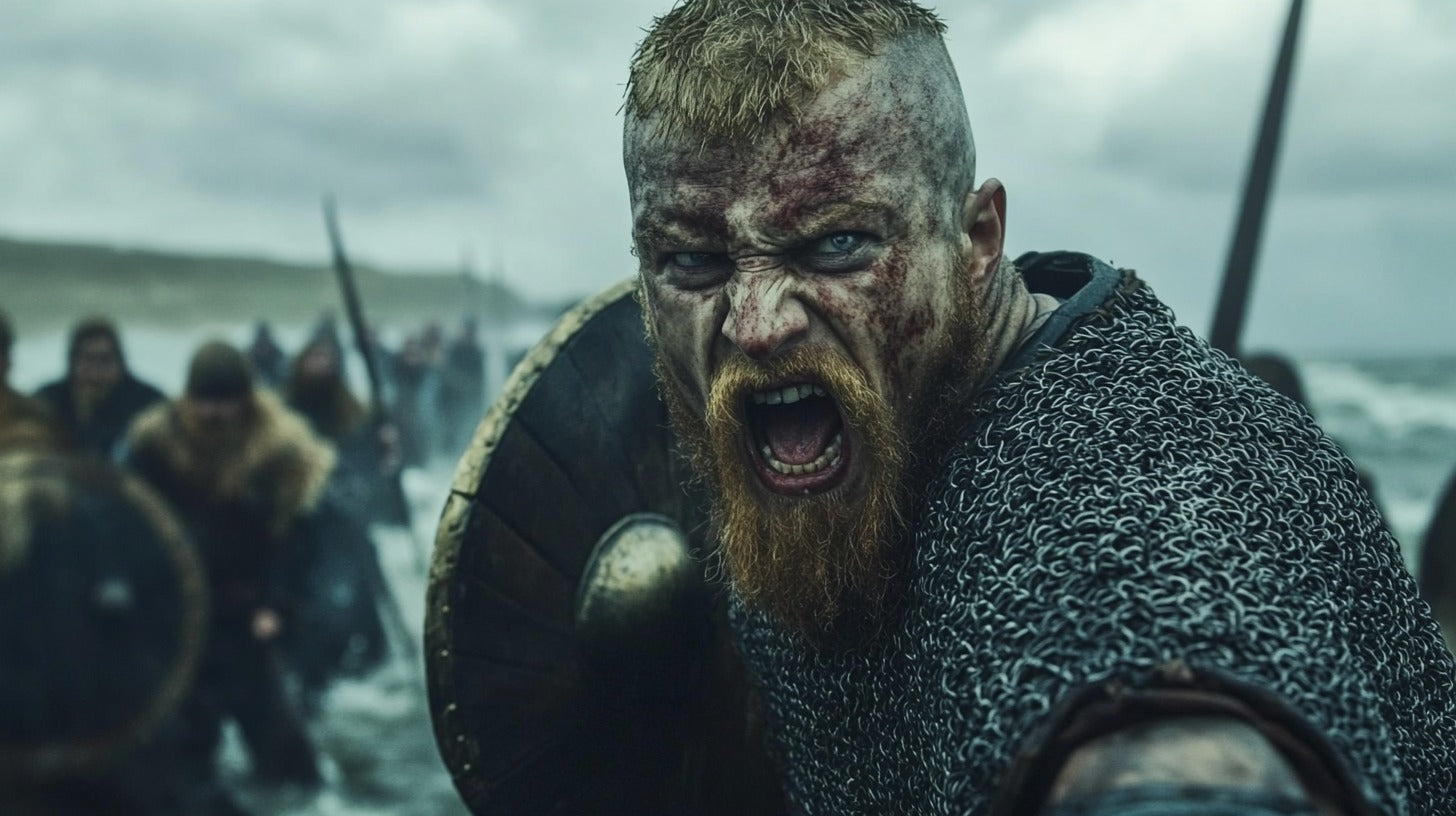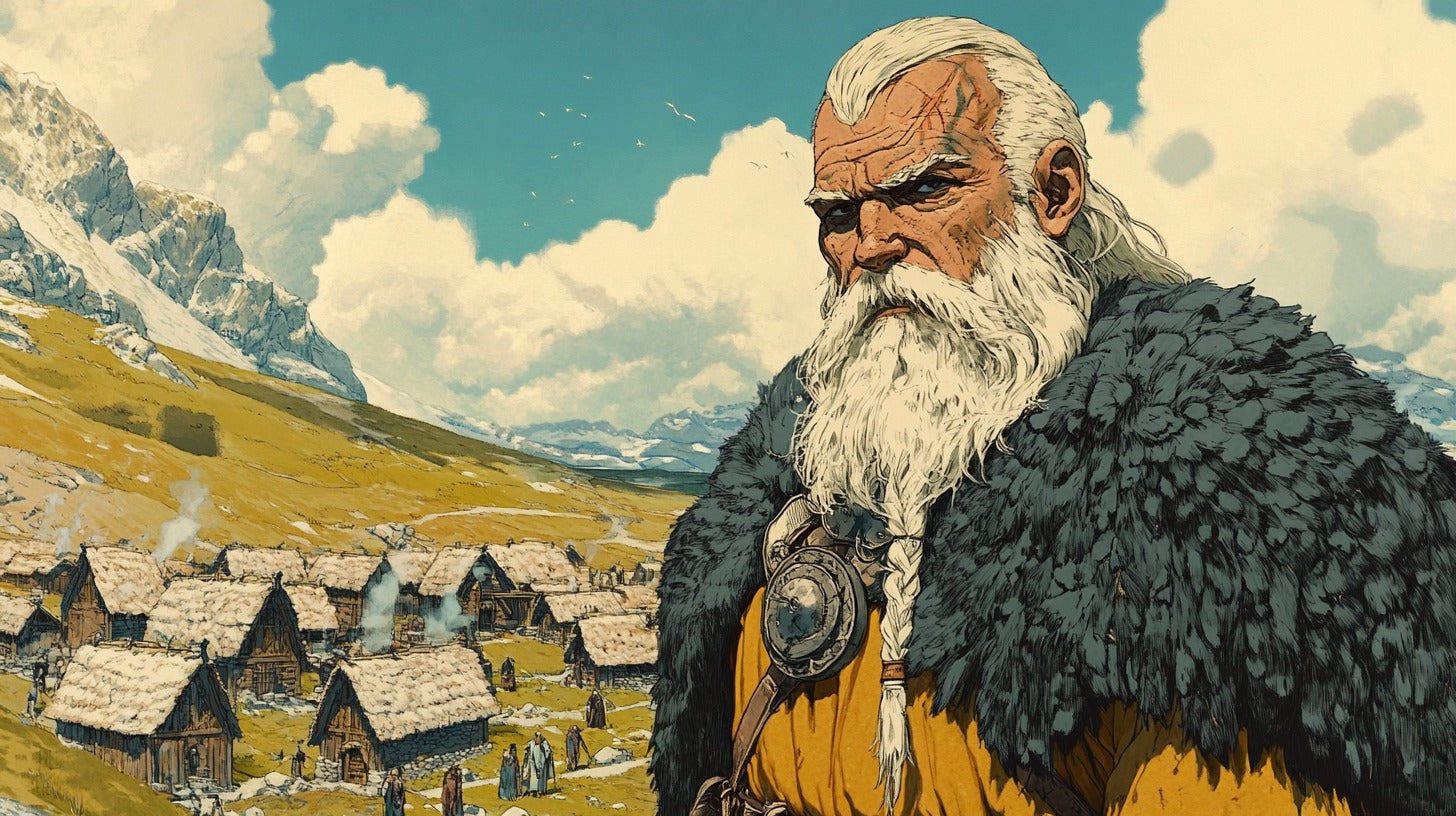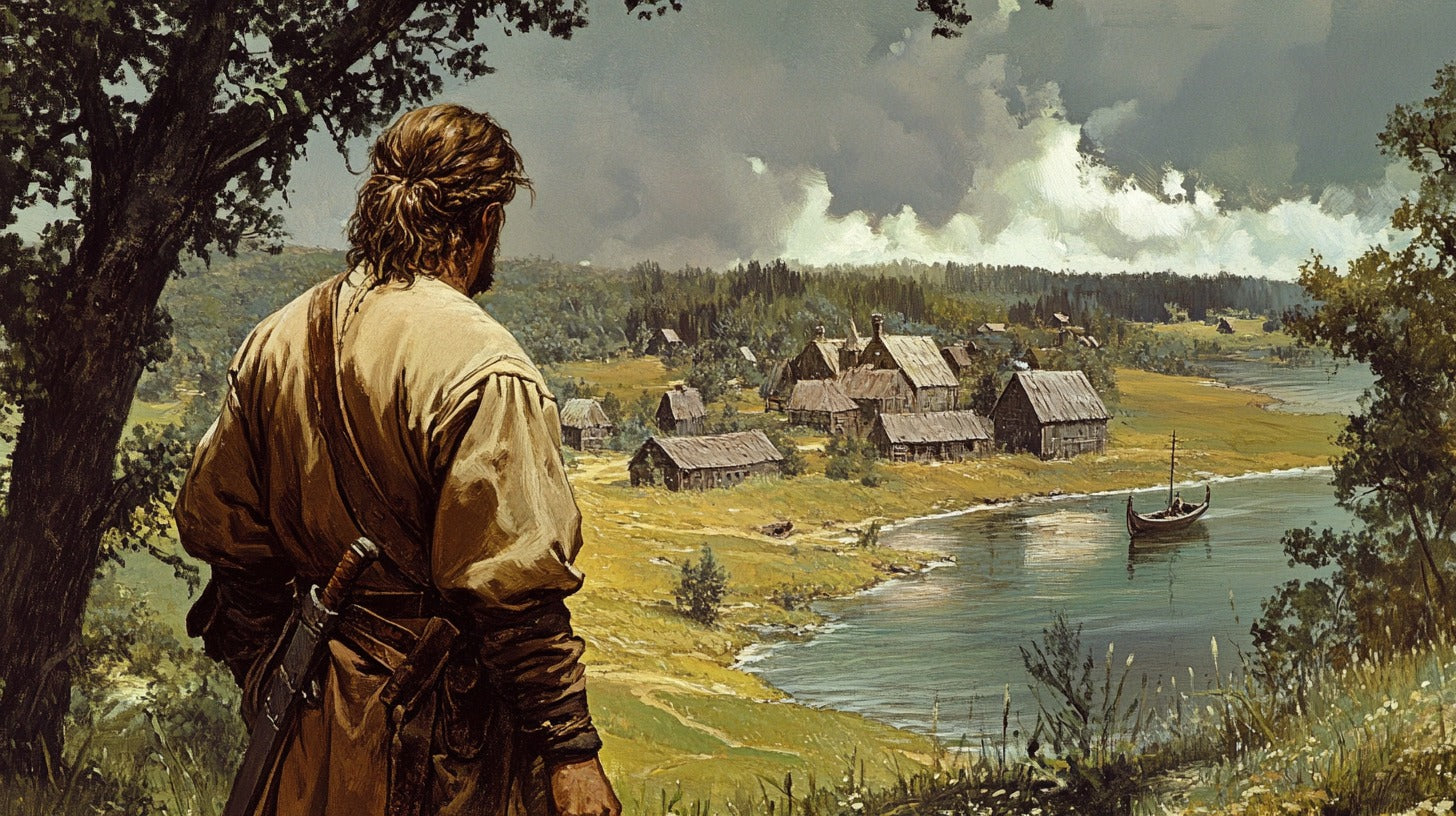
Dublin's Viking King: Ivar the Boneless in Ireland
In the turbulent seas of Irish history, few figures loom as large as Ivar the Boneless. This Viking warlord, already renowned for his exploits in England, turned his fierce gaze to the emerald shores of Ireland in the mid-9th century. His arrival would mark the beginning of a new era, one that would reshape the political, cultural, and genetic landscape of Ireland for centuries to come.
Ivar's Arrival on Irish Shores

The Political Landscape of 9th Century Ireland
When Ivar first set foot on Irish soil, he found a land divided. Ireland in the 9th century was a patchwork of petty kingdoms, each vying for supremacy. The High Kings of Tara held nominal authority, but in reality, power was fragmented and alliances were as changeable as the Irish weather.
This political disunity was both a challenge and an opportunity for Ivar. On one hand, it meant facing multiple opponents. On the other, it presented chances for alliances and divide-and-conquer tactics. Ivar, with his sharp mind and sharper sword, was well-equipped to navigate this complex landscape.
First Raids and Initial Impact
Ivar's initial forays into Ireland were likely exploratory raids, testing the defenses and gauging the wealth of potential targets. These early incursions sent shockwaves through Irish society. Monasteries, long considered sanctuaries, found themselves under attack. The Irish, accustomed to internal squabbles, now faced a foreign threat unlike any they had encountered before.
But Ivar was no mere raider. His ambitions stretched far beyond hit-and-run attacks. He saw in Ireland not just a land to plunder, but a kingdom to conquer.
The Siege and Capture of Dublin

Shield boss found at South Great George's st, Dublin / Photo: National Museum of Ireland
Strategies and Tactics
In 861, during the Viking Age, Ivar set his sights on Dublin, a prosperous trading settlement that would serve as an ideal base for further conquests. The siege of Dublin was a masterclass in Viking warfare. Ivar combined brute force with cunning strategy, using the element of surprise and exploiting divisions among the Irish defenders.
Imagine the scene: longships appearing suddenly in Dublin Bay, their dragon prows cutting through the mist. The clash of steel, the roar of battle cries, the acrid smell of smoke as buildings burned. Ivar was in his element, directing his forces with the precision of a chess master.
Establishing Viking Control
With Dublin under his control, Ivar began the process of transforming it from an Irish settlement into a Viking stronghold. He fortified the town, expanded the harbor, and encouraged trade. Dublin became not just a military base, but a thriving Norse-Gael city, a melting pot of Viking and Irish cultures.
But Ivar's ambitions didn't stop at Dublin's walls. From this strategic base, he began to extend his influence across Ireland.
Expansion Beyond Dublin

Alliances with Irish Kings
Ivar quickly realized that to control Ireland, he needed to work within its existing power structures. He began forming alliances with Irish kings, playing one against the other with Machiavellian skill. Some he intimidated into submission, others he won over with promises of wealth and power.
These alliances were often sealed with marriages, creating a new Norse-Gael aristocracy. Ivar himself may have taken an Irish wife, though historical records on this are frustratingly vague.
Conflicts with Native Irish Forces
Not all Irish rulers were willing to bend the knee to the Viking invader. Ivar faced fierce resistance from several quarters, most notably from the kings of Munster and Connacht. These conflicts were brutal affairs, with atrocities committed on both sides.
One particularly gruesome tale speaks of Ivar ordering the execution of Irish hostages by having their backs broken - a chilling demonstration of why he might have earned the moniker "the Boneless."
The Norse-Gael Kingdom

Merging of Viking and Irish Cultures
As Ivar's control solidified, a unique culture began to emerge in the areas under Viking rule. This Norse-Gael society blended elements of both Viking and Irish traditions. New art styles developed, combining Celtic and Norse motifs. The Irish language absorbed Norse loanwords, many of which persist in modern Irish.
In the streets of Dublin and other Viking settlements, you might have heard a mix of Norse and Irish being spoken, seen Irish monks rubbing shoulders with Viking merchants, smelled Irish stew cooking alongside Scandinavian dishes.
Economic Changes Under Viking Rule
Ivar's reign brought significant economic changes to Ireland. The Norsemen were not just warriors and raiders but also skilled traders and craftsmen. They established new trade routes, linking Ireland more closely with continental Europe and beyond.
Archaeology has revealed a boom in urban development during this period, with new towns springing up along the coasts. These settlements became hubs of commerce, their markets filled with goods from as far away as the Byzantine Empire and the Islamic world.
Ivar's Military Campaigns in Ireland

Urnes art Triquetra Mjolnir amulets
Notable Battles and Conquests
Ivar's military activities in Ireland were extensive, though the historical record is often frustratingly vague. We know he led campaigns against the kingdoms of Meath, Munster, and Connacht, but the details of these battles are often lost to time.
One notable expedition was against the monastery of Clonmacnoise in 866. This attack on one of Ireland's most revered religious sites sent shockwaves through the country and demonstrated Ivar's willingness to challenge the old order.
Treatment of Irish Opponents
Ivar's treatment of his Irish opponents was often brutal, in keeping with the harsh realities of warfare in the 9th century. Captured enemies might be enslaved, ransomed, or executed, depending on their value and Ivar's mood.
Yet he was also capable of pragmatism. Those who submitted to his rule could expect a degree of autonomy, as long as they remained loyal and paid tribute. This carrot-and-stick approach helped Ivar maintain control over a vast and diverse territory.
Legacy in Ireland

The family tree of the Dublin Scandinavian Dynasty / Illustration: Erakis
Long-term Political Impact
Ivar's conquests reshaped the political landscape of Ireland. The establishment of Viking kingdoms along the coast created a new power dynamic, one that would persist long after Ivar's death. The concept of urban centers as seats of power, introduced by the Vikings, would have a lasting impact on Irish political structures.
Cultural and Genetic Influence
The genetic legacy of Ivar and his followers can still be traced in the DNA of many Irish people today, particularly in coastal areas. Culturally, the Viking influence is evident in everything from place names to folklore.
The intermarriage between Vikings and Irish created a new Norse-Gael identity that would play a significant role in Irish history for centuries to come. In many ways, Ivar's arrival marked the beginning of Ireland's transition from an isolated island to a player on the European stage.
Ivar's Final Years in Ireland

Illustration of a Thistle Penannular found in Ireland
Conflicting Accounts of His Later Life
The end of Ivar's life is as shrouded in mystery as its beginning. Some sources suggest he returned to England in his later years, while others claim he remained in Ireland until his death. The truth may lie somewhere in between, with Ivar moving between his various domains as needed.
Myths and Legends of His Death
Like many legendary figures, Ivar's death became the subject of numerous myths and legends. Some tales speak of him dying in battle, others of him succumbing to a mysterious illness. One particularly colorful legend claims he was buried in a secret location, with his body serving as a talisman to protect Dublin from invasion.
Conclusion: Ivar's Lasting Impact on Irish History
Ivar the Boneless's time in Ireland was relatively short - perhaps no more than a decade or two. Yet in that brief span, he left an indelible mark on the country's history. His military prowess, political acumen, and cultural impact reshaped Ireland in ways that would persist for centuries.
From the Viking longphorts that grew into Ireland's first true cities, to the Norse-Gael culture that emerged from the blending of two peoples, Ivar's legacy can still be felt in Ireland today. He arrived as a conqueror, but in the end, he became a part of the complex tapestry of Irish history.
As we look back on Ivar's time in Ireland, we're reminded of the complex interplay between conflict and cultural exchange, between destruction and creation, that has shaped human history. In the story of Ivar the Boneless in Ireland, we see not just the tale of one man or one invasion, but a microcosm of the forces that have molded nations and cultures throughout time.
FAQs
- Did Ivar the Boneless really conquer all of Ireland?
While Ivar established significant control over parts of Ireland, particularly around Dublin and the east coast, he never conquered the entire island.
- How long did Ivar the Boneless stay in Ireland?
The exact duration of Ivar's time in Ireland is uncertain, but it's believed to have been somewhere between 10 to 20 years.
- Did Ivar the Boneless have any Irish descendants?
While there's no definitive proof, it's likely that Ivar had Irish descendants given the common practice of Vikings intermarrying with local populations.
- What was Ivar's relationship with the Irish church?
Ivar's relationship with the Irish church was generally hostile. Vikings often targeted monasteries for their wealth, though later Viking rulers did convert to Christianity.
- Are there any physical remnants of Ivar's rule in Ireland today?
While no structures can be definitively linked to Ivar himself, Viking-era artifacts and the remains of Viking settlements have been found in Dublin and other coastal areas.
References
Downham, C. (2007). Viking Kings of Britain and Ireland: The Dynasty of Ívarr to A.D. 1014. Dunedin Academic Press.
Ó Corráin, D. (1998). The Vikings in Ireland. In The Vikings in Ireland and Beyond (pp. 17-27). Four Courts Press.
Valante, M. A. (2008). The Vikings in Ireland: Settlement, Trade and Urbanization. Four Courts Press.
Byrne, F. J. (2001). Irish Kings and High-Kings. Four Courts Press.
Holman, K. (2003). Historical Dictionary of the Vikings. Scarecrow Press.







